欧洲儿童泌尿系感染诊治指南解读(完整版)
泌尿道感染诊治循证指南

三、影像学检查
4. 不同年龄儿童影像学检查推荐流程: >2 岁患儿:首次发热性UTI,可视病情而定。一般患儿完善泌尿 系超声即可;若超声异常,或临床表现不典型,或抗菌药物治 疗48 h无明显好转者,则建议按上述≤ 2岁者完善相关影像学检 查。
四、上、下泌尿道感染的鉴别
上泌尿道感染又称肾盂肾炎,主要指菌尿并有发热(≥ 38 ℃),伴有腰酸、 易激惹等不适。下泌尿道感染包括膀胱炎或尿道炎,通常患儿无全身症状 和体征。儿童泌尿道感染定位有时较为困难,C反应蛋白在临床上并无鉴
三、影像学检查
3.MCU 但是值得强调的是,需要追问患儿既往是 否曾有不明原因发热而未行尿液检查的病 史,因为临床一些所谓的“首次”发热性 泌尿道感染患儿,往往可能已经是感染的 复发,此时还是建议尽早完善MCU检查。
三、影像学检查
4. 不同年龄儿童影像学检查推荐流程: ≤ 2岁患儿:首次发热性UTI,建议完善泌尿系超声及DMSA检查。 如果泌尿系超声或DMSA检查结果异常,或是不典型泌尿道感 染表现,建议在急性感染控制后进一步行MCU检查。如果泌尿 系超声与DMSA 结果均未见异常,则可密切随访观察,如有感 染再次发作需考虑完善MCU 检查。
三、影像学检查
2.DMSA: (1)是诊断急性肾盂肾炎的金标准:典型表现呈单 个或多个局灶放射性减低或缺损区,但无容量丢失, 也可呈弥漫的放射性稀疏伴外形肿大。对发热性泌尿 道感染的婴幼儿,急性期行DMSA检查对于除外扩张 型VUR(Ⅲ~Ⅴ级)具有重要作用,因此急性期 DMSA检查可应用于评估是否需要进一步进行MCU 检查,意即本指南采纳自上而下分析法,更着重关注 于泌尿道感染时肾脏有无受累
证据水平及推荐等级
本指南中的证据水平及推荐等级根据中华医学会儿科学分会肾脏学组的要求, 参照欧洲心血管病学会提出的证据水平和推荐等级分级,其中证据水平分为 A、B、C 3个级别
头孢克肟详细说明书

【药物名称】中文通用名称:头孢克肟英文通用名称:Cefixime其他名称:阿帕奇、安的克妥、安的克威、安捷仕、氨噻肟烯头孢菌素、奥德宁、彼优素、达力芬、扶欣抗、汉光妥、汇新沙、积大希夫、基洛、今辰(头孢克肟)、久邦、君特、康哌、抗之霸(头孢克肟)、克力罗、克林盾、克沃莎(头孢克肟)、魁克、乐宁(头孢克肟)、立健克、洛伟克、诺百优、欧健、琪安、勤克沃、青可奕、瑞优达、赛可恩、舍尔、士瑞克、世福素、舒妥、数码宝贝、司力捷、速普乐、特力素、特普宁、天立威、威尤可、西复欣、先强严灵、新达欣、新福素、严逸、依萌泰、誉舒、再握、正卫佳、Aerocef、Cefiximum、Cefixoral、Ce fnixime、Cefspan、Cephoral、Denvar、Fixim、Necopen、Novacef、Oro ken、Suprax、Tricef。
【临床应用】CFDA说明书适应症本药适用于治疗敏感菌所致的下列感染:1.呼吸系统感染,如慢性支气管炎急性发作、急性支气管炎并发细菌感染、支气管扩张合并感染、肺炎、鼻窦炎。
2.泌尿系统感染,如肾盂肾炎、膀胱炎、淋球菌性尿道炎。
3.急性胆道系统细菌性感染,如胆囊炎、胆管炎。
4.其他感染,如中耳炎、猩红热。
其他临床应用参考用于性侵犯受害者预防性传播疾病。
临床指南2014年欧洲儿童急性胃肠炎治疗循证指南——抗感染治疗方案解读2015年美国疾病控制中心性传播疾病的诊断和治疗指南(续)——淋病的诊断和治疗指南2015年美国疾病控制中心性传播疾病诊断和治疗指南更新内容和解读(续完) 解读“美国感染性疾病学会儿童和成人急性细菌性鼻及鼻窦炎临床指南”抗菌药物临床应用指导原则(2015年版)慢性阻塞肺疾病急性加重抗感染治疗川渝专家建言欧洲2015年儿童泌尿系感染诊治指南解读欧洲儿童急性胃肠炎处理循证指南(2014年版)实用儿科诊疗规范-儿科:感染性疾病(五)血液净化急诊临床应用专家共识中国成人社区获得性肺炎诊断和治疗指南(2016年版)中国儿童急性感染性腹泻病临床实践指南【用法与用量】成人·常规剂量·普通感染1.口服给药一次100mg,一日2次。
欧洲泌尿外科协会指南解读小儿上尿路扩张疾病(UPJ和UVJ)
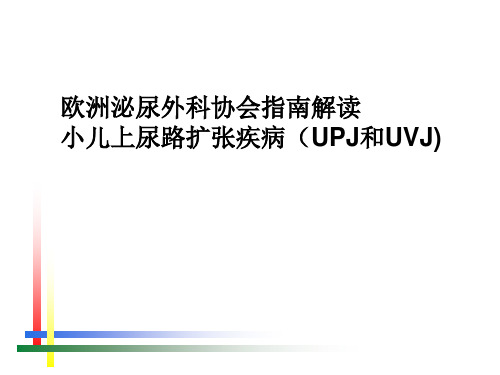
上尿路扩张疾病对于外科医生最大的挑战:决定的治
疗能否给病人带来好处
决策
Dilatation of the UUT remains a significant clinical challenge in deciding which patient will benefit from treatment. PAEDIATRIC UROLOGY - LIMITED UPDATE MARCH 2017
2.2产后超声
• 产后48小时由于体液浓缩,不 做超声,双侧重度积水、孤立 肾积水、羊水少除外
• 超声观察 肾盂前后径,集合系统扩张情况, 肾实质厚度、肾脏大小 输尿管 膀胱壁厚度、残余尿
2.3排尿性膀胱尿道造影
• VCU必须做 • 最重要明确是否有输尿管反流,
占感染的25% • 尿道瓣膜 • 输尿管膨出 • 憩室 • 神经性膀胱
• 机器人效果相同,增加工作量,费用
• 没有任何证据说明微创对于非常小的孩 子有好处
• 没有任何数据说明推迟手术的时间点
喜欢做哪个手术?
微创:家长喜欢,年轻医生学习快 从早期的几位医师表演,到目前很多人应用
3.3巨输尿管 3.3.1观察
• 巨输尿管85%可以自消,对于没有梗阻证据的 要观察,可以适当用预防量抗菌素
2.4利尿性肾图
常用于评价肾功能,判断严重程度 • 99mTc MAG3生后4-6周做,让肾脏成熟
• 充分水化,插导尿管排空膀胱,用速尿。 • 检查前喝水,检查前15分钟,要静脉补充生理盐水
15ml/kg,30分钟输进去,4ml/kg/h在检查过程中补充 NS。 • 速尿1mg/kg,一岁以内,1-6岁0.5mg/kg
儿童尿路感染及原发性膀胱输尿管反流临床诊治的专家共识教学内容
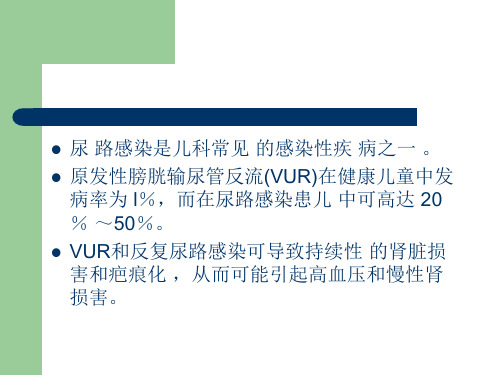
原发性膀胱输尿管反定 位和疤痕的发现。DMSA无异常发 现情况下罕少发现存在反流,而在 DMSA发现肾瘢痕患儿中反流的阳 性率相当高。
原发性膀胱输尿管反流的诊断
对 >4岁,B超显像泌尿系异常者,需在感染控 制后进行 MCU检查。对 2~4岁者 ,可根据 病情而定 。
①如 DMSA示肾实质损害较严重或合并双侧肾实质损 害,需尽早行 MCU检查。
② 如 DMSA示 肾实质损害较轻 ,可暂缓 MCU检查, 3个月后 随访 DMSA,期 间建议应用 预防量抗生 素 (1/3治疗量)睡前顿服。
③ B超显像泌尿系异常者需在感染控制后立 即行 MCU检查 。
根据DMSA扫描摄影征象将肾瘢痕分为四 级:
预防性抗 生素的应用
对 <2岁 的患儿 ,持续应用预防量抗生素 (1/ 3治疗量),睡前顿服直到进行所有影像学检查。
手术治疗
原发性膀胱输尿管反流的治疗
1)对Ⅲ级以上的 VUR患儿 2)如有下列情况 ,宜尽早进行手术: ①预防感染不能有效控制尿路感染的反复; ②就诊时即发现肾发育延迟; ③随访中出现肾功能不全 ,产生新的疤痕。
治疗
首次尿路感染的治疗:
1)急性期治疗: ①对 <3个月患儿的治疗静脉应用敏感抗生素治疗
10~14 d。 ②对 <2岁伴发热患儿的治疗,静脉应用敏感抗生素治
疗 10~14 d;或先静脉应用 2~4 d,继而口服抗生 素治疗 ,总疗程 10~14d ③患儿一般情况较好时 ,可口服敏感抗生素治疗 10~14 d。
保守治疗
①预防尿路感染的复发:选择敏感抗生素治疗剂 量的 1/3,睡前顿服;推荐首选呋喃妥因、 磺胺甲基异恶唑;如有小婴儿中服用呋喃妥因 伴随消化道不 良反应剧烈等 ,可选择阿莫西 林一克拉维酸钾或头孢克洛类药物口服。
儿童常见肾脏疾病诊治循证指南(试行):泌尿系感染诊断治疗指南

儿童常见肾脏疾病诊治循证指南(试行):狼疮性肾炎诊断治疗指南一、前言泌尿系感染(UTD是儿科常见的感染性疾病之一⑴,旦婴幼儿uτι常合并膀胱输尿管反流(VUR)等先天性尿路畸形(VUR)在婴幼儿发热性UTI中可高达20%~40%).VUR和反复UTI可导致持续性的肾脏损害和瘢痕化,从而可能引起高血压和慢性肾衰竭。
早期发现和诊断婴幼儿UTL并给予合理处置尤为重要。
为规范我国儿童UT工的诊断和治疗,中华医学会儿科学分会肾脏病学组起草本指南试行稿,旨在反映当前最佳临床实践证据,为临床儿科医生提供符合我国国情的、可操作性的中国儿童UTl诊断和治疗的参考方案。
二、证据来源1 .检索文献数据库:(1)外文:EMBASE X MEDLINE、CoehraneLibrary.OVid循证医学数据库。
(2)中文:CHKD(中文全文数据库)、CBMDiSC(中国生物医学文献数据库)、CMCC(中文生物医学期刊数据库)、万方数据资源系统、中文科技期刊全文数据库(VIP)、CEBM∕CCD(中国循证医学/Cochrane中心数据库)。
(3)手工检索:已出版的国内、外UT工诊断与治疗指南。
2 .检索关键词:泌尿道感染(Urinaryt×actinfection,UTI)>膀胱输尿管反流(vesicouretericreflux,VUR)»治疗(treatment)、Meta分析(meta-analysis)、随机临床试验(randomizedclinicaltrial,RCT)>儿童(ChiIdorchildhood),>3 .检索结果:检索截止时间为2008年9月,1999年至2008年共检索到相关的指南5篇,系统评价和Meta分析共14篇。
三、证据评价本指南中的证据水平及推荐等级根据中华医学会儿科学分会肾脏病学组的要求,参照欧洲心血管病学会提出的证据水平和推荐等级分级,其中证据水乎分为A、B、C3个级别,推荐等级分为I、Ila、Ilb和川共4个等级(表表1证据水平及推荐等级证据水平证据来源于多个随机临床试验(RCT)或荟萃分析B 证据来源于单个的RCT或大样本非随机临床研究C 证据来源于专家共识和(或)小样本研究、回顾性研究以及注册登记的资料推荐等级I 证据和(或)共识对于诊断程序或治疗是有确定疗效的、可实施的和安级全的II 对治疗的有效性具有分歧。
欧洲泌尿外科学会2017年版肾盂输尿管交界处梗阻诊疗指南解读
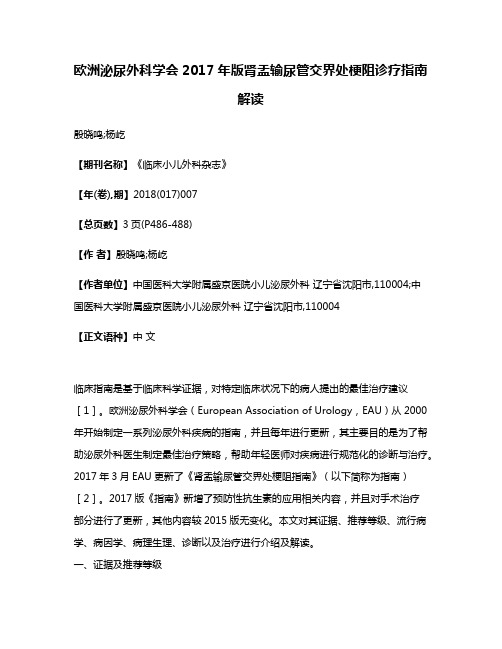
欧洲泌尿外科学会2017年版肾盂输尿管交界处梗阻诊疗指南解读殷晓鸣;杨屹【期刊名称】《临床小儿外科杂志》【年(卷),期】2018(017)007【总页数】3页(P486-488)【作者】殷晓鸣;杨屹【作者单位】中国医科大学附属盛京医院小儿泌尿外科辽宁省沈阳市,110004;中国医科大学附属盛京医院小儿泌尿外科辽宁省沈阳市,110004【正文语种】中文临床指南是基于临床科学证据,对特定临床状况下的病人提出的最佳治疗建议[1]。
欧洲泌尿外科学会(European Association of Urology,EAU)从2000年开始制定一系列泌尿外科疾病的指南,并且每年进行更新,其主要目的是为了帮助泌尿外科医生制定最佳治疗策略,帮助年轻医师对疾病进行规范化的诊断与治疗。
2017年3月EAU更新了《肾盂输尿管交界处梗阻指南》(以下简称为指南)[2]。
2017版《指南》新增了预防性抗生素的应用相关内容,并且对手术治疗部分进行了更新,其他内容较2015版无变化。
本文对其证据、推荐等级、流行病学、病因学、病理生理、诊断以及治疗进行介绍及解读。
一、证据及推荐等级本指南证据及推荐等级遵循改良的牛津循证医学中心证据水平分级系统。
证据等级(level of evidence,LE):1a:证据从随机试验 meta 分析中获得;1b:证据从至少一个随机试验获得;2a:证据从一个设计很好的非随机对照研究中获得;2b:证据从至少一个其他类型的准试验研究中获得;3:证据从设计很好的非试验研究中获得,如病例对照研究、横断面调查和病例报告;4:证据从专家委员会报告、共识、观点或临床经验中获得。
推荐等级分级(grade of recommendation,GR):A:基于高质量的临床研究、专家一致性推荐及至少一个随机试验;B:基于严格实施的临床研究,但是没有随机化;C:没有可直接应用的质量很好的临床研究。
二、流行病学、病因和病理生理肾盂输尿管交界处梗阻(ureteropelvic junction obstruction,UPJO)为尿液从肾盂流入近端输尿管障碍,导致集合系统扩张,并可能引起肾脏功能损害的一种泌尿系畸形,是引起新生儿肾积水的最常见病因,约占肾积水病因的40%(LE:1)。
欧洲泌尿外科学会上尿路尿路上皮癌指南解读:2017更新
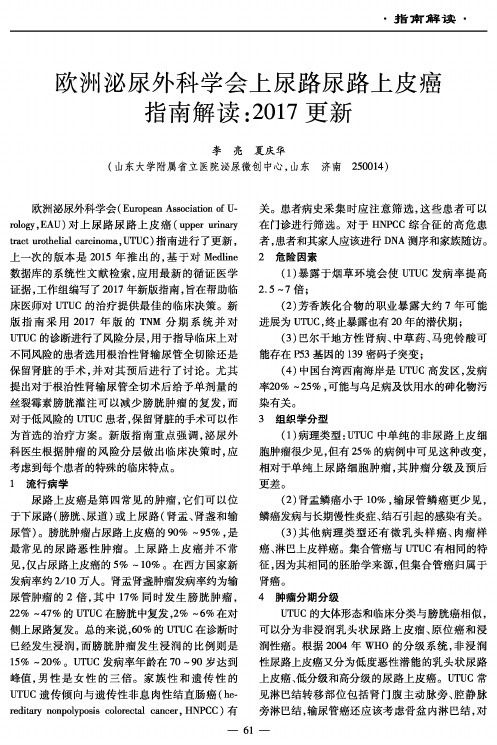
数据库的系统性文献检索,应 用 最 新的循证医学
证据,工作组编写了 2 0 1 7 年新版指南,旨在帮助临 床 医 师 对 U TU C 的治疗提供最佳的临床决策。新 版 指 南采用2017年 版 的 TNM分期系统并对 U TU C的诊断进行了风险分层,用于指导临床上对
不同风险的患者选用根治性肾输尿管全切除还是 保留肾脏的手术,并 对 其 预 后 进 行 了 讨 论 。尤其 提出对于根治性肾输尿管全切术后给予单剂量的 丝裂霉素膀 胱 灌 注 可 以 减 少 膀 胱 肿 瘤 的 复 发 ,而
肿瘤复发率更高。 5 诊断
U T U C 的常见症状包括肉眼或镜下血尿(7〇% ~ 8 0 % ) 、腰 痛 ( 2 0 % ) 和 腰 腹 部 包 块 (1 0 % ) ,全身
症状(厌食、体重下降、盗汗 、发热 、骨 痛 等 )的出现 提示预后不良,需进行更加严格的 评 估 肿 瘤 的 转 移情况。C T U 对 确 诊 U T U C 是现有影像学检查中 精 确 度 最 髙 的 ,敏 感 性 6 7 % ~ 1 0 0 % 、特 异 性 9 3 % ~ 9 9 % ,肾盂积水出现提示高危的病理类型, 预后较差。淋 巴 结 肿 大 高 度 提 示 肿 瘤 的 转 移 。 M R U 适 合 不 能 行 C T U 检 查 的 患 者 ,对 于 小 于 2cm 的肿瘤敏感性7 5 % ,但 M R U 对比剂有导致肾源性 系统性纤维化的风险,不能用 于 严 重 肾 功 能 不 全 的患者(肌酐清除率小于30ml/ min ) 。尿脱落细胞 学检查阳性高度提示U T U C (当排除膀胱、尿道、前 列腺原位癌时),U T U C 尿脱落细胞学检查敏感性 低于膀胱肿瘤,应 严 格 操 作 。膀 胱 镜检查和逆行 肾盂输尿管造影仍是重要的检查手段,因为可能 会破坏细胞学检查标本,应在逆 行 造 影 检 查 前 先 行尿脱落细胞学检查。F I S H 对 U T U C 筛查意义有 限。输尿管软镜活检可确定9 0 % 的病例并确定肿 瘤 的 分 级 ,假 阳 性 率 较 低 。 6 预后
儿童泌尿系感染诊断治疗指南
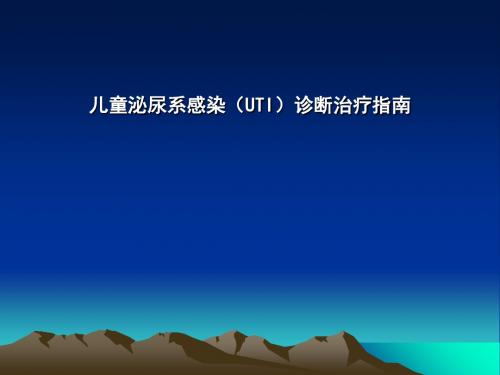
抗菌治疗
• 上尿路感染/急性肾盂肾炎的治疗 ④ ④在抗生素治疗48h后需评估治疗效果,包 • 括临床症状、尿检指标等。若48h后未能达 到预期效果,需要重新留取尿液进行尿培 养细菌学检查。 • ⑤如果影像学相关检查尚未完成,在足量 抗生素治疗疗程结束后仍需继续予以小剂 量(1/3~1/4治疗量)的抗生素口服治疗, 直到影像学检查显示无VUR等尿路畸形。
抗菌治疗
• 下尿路感染/膀胱炎的治疗 • ①口服抗生素治疗7~14天(标准疗程); • ②口服抗生素2~4天(短疗程);标准疗程和短 疗程在临床症状持续时间、菌尿持续时间、UTI复 发、药物依从性和耐药发生率方面均无明显差别。 本指南推荐短疗程。 • ③在抗生素治疗48小时后需评估治疗效果,包括 临床症状、尿检指标等。若48h后未能达到预期 的治疗效果,需重新留取尿液进行尿培养细菌学 检查。
3.影像学检查: 目的:①辅助UTI定位;②检查泌尿系统有无 先天性或获得性畸形;③了解慢性肾损害 或瘢痕进展情况。 常用的:B超、排泄性膀胱尿路造影 (MCU)、静态核素肾扫描等。
影像学检查
• B超:建议伴有发热的UTI均行B超检查。主要是 发现和诊断泌尿系统发育畸形。 • 核素肾静态扫描(99mTc-DMSA):①诊断急性 肾盂肾炎(APN)的金标准:APN时,由于肾实 质局部缺血及肾小管功能障碍导致对DMSA摄取 减少。其诊断该病的敏感性及特异性分别为96% 和98%。②肾瘢痕的发现:国内外学者均发现首 次UTI的患儿在DMSA无异常发现的情况下罕见 VUR存在,而在DMSA发现肾瘢痕的患儿中VUR 的阳性率相当高。推荐在急性感染后3~6月行 99mTc-DMSA以评估肾瘢痕。
影像学检查
排泄性膀胱尿路造影(MCU):系确诊VUR的基本 方法及分级的“金标准”。①<2岁的患儿:UTI 伴有发热症状者,无论男女,在行尿路B超检查 后无论是否异常,均建议在感染控制后行MCU检 查。家属对MCU有顾虑者,应尽早行99mTcDMSA检查:Ⅰ.如果DMSA肾实质损害较严重或 合并双侧肾实质损害,需尽早行MCU检查;Ⅱ.如 果DMSA肾实质损害较轻,也可在交代可能性后 暂缓MCU检查,且在3月后随访DMSA;Ⅲ.B超 显像泌尿系统异常者需在感染控制后立即行MCU 检查。
儿童尿路感染指南共识【34页】
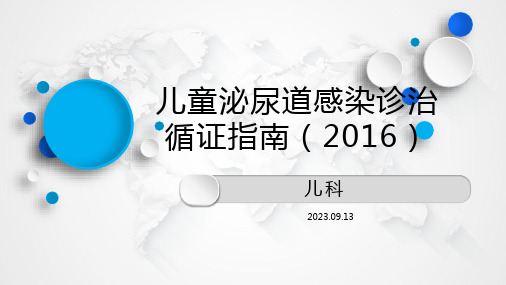
最新指南
预防儿童尿路感染的抗生素预防(2023指南)
不建议在以下情况下低剂量持续抗生素预防:以前有尿路感染(UTI)的儿童、复发性UTI、任何级别的膀胱输尿管反流(VUR)、孤立性肾积水、神经源性膀胱。对于有明显梗阻性泌尿道疾病的儿童,建议在手术矫正前给予CAP治疗。对于不推荐CAP的情况,建议在早期诊断尿路感染发作和及时抗生素治疗的基础上进行密切监测。
病因和发病机制(3)膀胱输尿管返流与泌尿道感染发生和发展关系密切,膀胱输尿管返流可为先天发育异常或后天因素所致。婴儿的发病数较高,随年龄增长而渐缓解。(4)排尿功能障碍如神经性膀胱、不稳定膀胱和非神经性膀胱也易致泌尿道感染 (5)机体防御能力低下如营养不良、肾病综合征、分泌型IgA缺乏等均易致泌尿道感染 (6)其他:如泌尿道器械检查、留置导尿管、不及时更换尿布、蛲虫症亦可导致泌尿道感染。
在抗生素治疗48 h后需评估治疗效果,包括临床症状、尿检指标等。若抗生素治疗48 h后未能达到预期的治疗效果,需重新留取尿液进行尿培养细菌学检查
影像学检查尚未完成,在足量抗生素治疗疗程结束后仍需继续予以小剂量(1/3—1/4治疗量)的抗生素口服治疗,直至影像学检查显示无VUR等尿路畸形
上尿路感染/急性肾盂肾炎的治疗:疗程7~14 d
01
控制症状
02
去除诱发因素
03
预防再发
04
治疗原则
副作用
抗菌药物
抗菌谱
药物浓度
感染部位
选药依据
在肾组织、尿液、血液中都应有较高的浓度
药物抗菌能力强,抗菌谱广,强效杀菌剂,且不易产生耐药菌株
没有药敏试验结果,推荐使用二代以上头孢菌素、氨苄青霉素/棒酸盐复合物
对肾孟肾炎应选择血浓度高的药物,对膀胱炎应选择尿浓度高的药物
欧洲儿童泌尿系感染诊治指南解读(完整版)
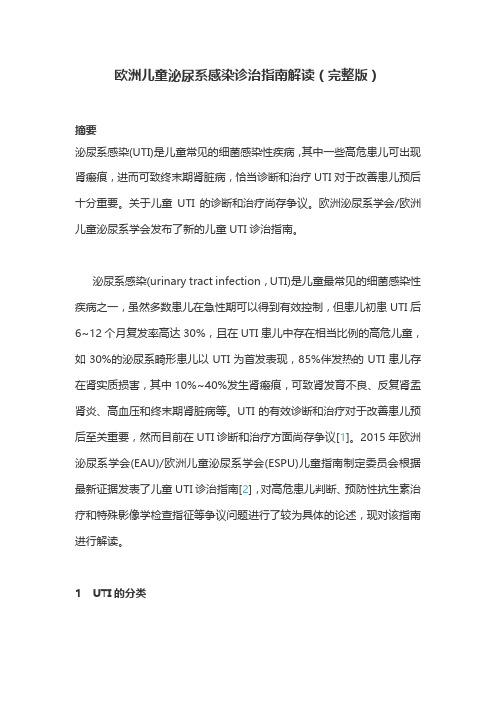
欧洲儿童泌尿系感染诊治指南解读(完整版)摘要泌尿系感染(UTI)是儿童常见的细菌感染性疾病,其中一些高危患儿可出现肾瘢痕,进而可致终末期肾脏病,恰当诊断和治疗UTI对于改善患儿预后十分重要。
关于儿童UTI的诊断和治疗尚存争议。
欧洲泌尿系学会/欧洲儿童泌尿系学会发布了新的儿童UTI诊治指南。
泌尿系感染(urinary tract infection,UTI)是儿童最常见的细菌感染性疾病之一,虽然多数患儿在急性期可以得到有效控制,但患儿初患UTI后6~12个月复发率高达30%,且在UTI患儿中存在相当比例的高危儿童,如30%的泌尿系畸形患儿以UTI为首发表现,85%伴发热的UTI患儿存在肾实质损害,其中10%~40%发生肾瘢痕,可致肾发育不良、反复肾盂肾炎、高血压和终末期肾脏病等。
UTI的有效诊断和治疗对于改善患儿预后至关重要,然而目前在UTI诊断和治疗方面尚存争议[1]。
2015年欧洲泌尿系学会(EAU)/欧洲儿童泌尿系学会(ESPU)儿童指南制定委员会根据最新证据发表了儿童UTI诊治指南[2],对高危患儿判断、预防性抗生素治疗和特殊影像学检查指征等争议问题进行了较为具体的论述,现对该指南进行解读。
1 UTI的分类与国内指南[3]略有不同,该指南根据感染部位、发病次数、症状和混杂因素对UTI进行了较为完整的分类(表1),其中对复发性UTI的定义仅按照发病次数,而不包含感染部位的因素。
表1泌尿系感染的分类及表现Table 1Classification and manifestation of urinary tract infection2 病史收集和体格检查要点该指南对病史收集和体检要点进行了阐述(表2),其中是否有便秘以往国内较少重视,有待关注。
表2泌尿系感染的病史收集和体格检查要点Table 2The key information on disease history and physical examination of urinary tract infection3 尿液和血液检查该指南强调尿液采集尽可能在抗生素应用前完成。
2014EAUESPU指南:儿童尿路感染
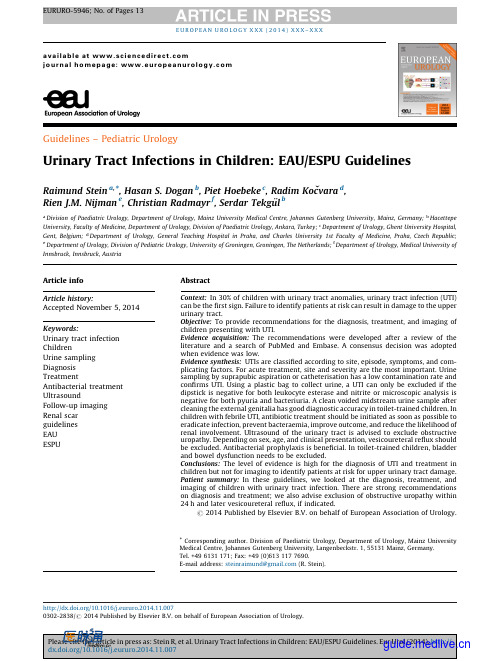
Guidelines –Pediatric UrologyUrinary Tract Infections in Children:EAU/ESPU GuidelinesRaimund Stein a ,*,Hasan S.Dogan b ,Piet Hoebeke c ,Radim Kocˇvara d ,Rien J.M.Nijman e ,Christian Radmayr f ,Serdar Tekgu¨l b aDivision of Paediatric Urology,Department of Urology,Mainz University Medical Centre,Johannes Gutenberg University,Mainz,Germany;bHacettepeUniversity,Faculty of Medicine,Department of Urology,Division of Paediatric Urology,Ankara,Turkey;cDepartment of Urology,Ghent University Hospital,Gent,Belgium;dDepartment of Urology,General Teaching Hospital in Praha,and Charles University 1st Faculty of Medicine,Praha,Czech Republic;eDepartment of Urology,Division of Pediatric Urology,University of Groningen,Groningen,The Netherlands;fDepartment of Urology,Medical University ofInnsbruck,Innsbruck,AustriaE U R O P E A N U R O L O G Y X X X (2014)X X X –X X Xa v a i l ab l e a t ww w.sc i e n c ed i re c t.c o mj o u r n a l h o m e p a g e :w w w.e u r o p e a n u r o l o g y.c omArticle infoArticle history:Accepted November 5,2014Keywords:Urinary tract infection ChildrenUrine sampling Diagnosis TreatmentAntibacterial treatment UltrasoundFollow-up imaging Renal scar guidelines EAU ESPUAbstractContext:In 30%of children with urinary tract anomalies,urinary tract infection (UTI)can be the first sign.Failure to identify patients at risk can result in damage to the upper urinary tract.Objective:To provide recommendations for the diagnosis,treatment,and imaging of children presenting with UTI.Evidence acquisition:The recommendations were developed after a review of the literature and a search of PubMed and Embase.A consensus decision was adopted when evidence was low.Evidence synthesis:UTIs are classified according to site,episode,symptoms,and com-plicating factors.For acute treatment,site and severity are the most important.Urine sampling by suprapubic aspiration or catheterisation has a low contamination rate and confirms ing a plastic bag to collect urine,a UTI can only be excluded if the dipstick is negative for both leukocyte esterase and nitrite or microscopic analysis is negative for both pyuria and bacteriuria.A clean voided midstream urine sample after cleaning the external genitalia has good diagnostic accuracy in toilet-trained children.In children with febrile UTI,antibiotic treatment should be initiated as soon as possible to eradicate infection,prevent bacteraemia,improve outcome,and reduce the likelihood of renal involvement.Ultrasound of the urinary tract is advised to exclude obstructive uropathy.Depending on sex,age,and clinical presentation,vesicoureteral reflux should be excluded.Antibacterial prophylaxis is beneficial.In toilet-trained children,bladder and bowel dysfunction needs to be excluded.Conclusions:The level of evidence is high for the diagnosis of UTI and treatment in children but not for imaging to identify patients at risk for upper urinary tract damage.Patient summary:In these guidelines,we looked at the diagnosis,treatment,and imaging of children with urinary tract infection.There are strong recommendations on diagnosis and treatment;we also advise exclusion of obstructive uropathy within 24h and later vesicoureteral reflux,if indicated.#2014Published by Elsevier B.V.on behalf of European Association of Urology.*Corresponding author.Division of Paediatric Urology,Department of Urology,Mainz University Medical Centre,Johannes Gutenberg University,Langenbeckstr.1,55131Mainz,Germany.Tel.+496131171;Fax:+49(0)6131177690.E-mail address:steinraimund@ (R.Stein)./10.1016/j.eururo.2014.11.0070302-2838/#2014Published by Elsevier B.V.on behalf of European Association of Urology.1.IntroductionIn 30%of children with urinary tract anomalies,urinary tract infection (UTI)can be the first sign [1].If we fail to identify patients at risk,damage to the upper urinary tract may occur.Up to 85%of infants and children with febrile UTI have visible photon defects on technetium Tc 99–labelled dimercaptosuccinic acid (DMSA)scanning,and 10–40%of these children have permanent renal scarring [2–4]that may lead to poor renal growth,recurrent pyelonephritis,impaired glomerular function,early hypertension,end-stage renal disease,and preeclampsia [5–10].Identifying children at risk of renal parenchymal damage and follow-up imaging after UTI is controversial.In these guidelines,we provide recommendations for the diagnosis,treatment,and imaging of children presenting with UTI based on evidence,and when this is lacking,based on expert consensus.2.BackgroundUTI is the most common bacterial infection in childhood [11–14],and up to 30%of infants and children experience recurrent infections during the first 6–12mo after initial UTI [15,16].In very young infants,symptoms of UTI differ in many ways from those in older infants and children.The prevalence is higher in the first age group,with a male predominance.Most infections are caused by Escherichia coli ,although in the first year of life Klebsiella pneumoniae ,Enterobacter spp,Enterococcus spp,and Pseudomonas are more frequent than later in life,and there is a higher risk of urosepsis compared with adulthood [17–19].The incidence of UTIs depends on age and sex.In the first year of life,UTIs are more common in boys (3.7%)than in girls (2%).This is even more pronounced in febrile infants in the first 2mo of life,with an incidence of 5%in girls and 20.3%in uncircumcised boys,as demonstrated in one prospective study of >1000patients using urine specimens obtained by catheterisation [18].Later,the incidence changes,and about 3%of prepubertal girls and 1%of prepubertal boys are diagnosed with a UTI [17–19].3.MethodologySeveral guidelines on dealing with specific subgroups of UTI are currently available,some of which are driven by economic and health care issues [20–22].The recommen-dations in these guidelines were developed by the European Association of Urology (EAU)/European Society for Paediat-ric Urology (ESPU)Paediatric Guidelines Committee after a review of the literature and a search of PubMed and Embase for UTI and newborn,infants,preschool,school,child ,and adolescent .A consensus decision was adopted when evidence was low.In these cases,all relevant papers and statements were discussed by all the authors until a consensus was achieved.The same criteria for the levels of evidence and grades of recommendation as in the EAU guidelines were used [23].4.ClassificationThe four widely used infection classification systems depend on the site,episode,symptoms,and complicating factors.For acute treatment,the site and severity are the most important.4.1.Classification according to siteCystitis (lower urinary tract)is inflammation of the urinary bladder mucosa with symptoms including dysuria,stran-guria,frequency,urgency,malodorous urine,incontinence,haematuria,and suprapubic pain.However,in newborns and infants,these symptoms are rarely diagnosed accurately.Pyelonephritis (upper urinary tract)is diffuse pyogenic infection of the renal pelvis and parenchyma with symptoms including fever (!388C).But unlike adults,infants and young children may have nonspecific signs such as poor appetite,failure to thrive,lethargy,irritability,vomiting,or diarrhoea.4.2.Classification according to episodeClassifications are first infection and recurrent infection ,which is subdivided into unresolved or persistent and reinfection [24].4.3.Classification according to symptomsAsymptomatic bacteriuria (ABU)indicates attenuation of uropathogenic bacteria by the host or colonisation of the bladder by nonvirulent bacteria that are incapable of activating a symptomatic response (no leucocyturia or symptoms).In patients with significant bacteriuria,leuco-cyturia can be present without any symptoms.Symptomatic UTI includes irritative voiding symptoms,suprapubic pain (cystitis),fever,and malaise (pyelonephri-tis).In patients with a neurogenic bladder and malodorous urine,it is difficult to distinguish between ABU and symptomatic UTI.4.4.Classification according to complicating factorsUncomplicated UTI is an infection in a patient with a morphologic and functional normal upper and lower urinary tract,normal renal function,and a competent immune system.Complicated UTI occurs in newborns,in most patients with clinical evidence of pyelonephritis,and in children with known mechanical or functional obstructions or problems of the upper or lower urinary tract [25].5.Diagnostic work-up5.1.Medical historyThe site,episode,symptoms,and complicating factors are identified by taking the patient’s history.This includes questions on primary (first)or secondary (recurring)E U R O P E A N U R O L O G Y X X X (2014)X X X –X X X2infection,febrile or nonfebrile UTIs;malformations of the urinary tract (eg,pre-or postnatal ultrasound [US]screening),previous operations,drinking,and voiding habits;family history;whether there is constipation or the presence of lower urinary tract symptoms;and sexual history in adolescents.5.2.Clinical signs and symptomsFever may be the only symptom of UTI,especially in young children [14,26–30].Newborns with pyelonephritis or urosepsis can present with nonspecific symptoms (failure to thrive,jaundice,vomiting,hyperexcitability,lethargy,hypothermia,and sometimes without fever)[31,32].Septic shock is unusual,even with high fever [24],unless obstruction is present or the child is otherwise compro-mised.In older children,lower urinary tract symptoms include dysuria,stranguria,frequency,urgency,malodor-ous urine,incontinence,haematuria,and suprapubic pain,and for the upper urinary tract,fever and flank pain.UTI in infancy may also be accompanied by a transient pseudohypoaldosteronism with profound hyponatraemia with or without hyperkalaemia [33,34].5.3.Physical examinationA complete paediatric physical examination is required to exclude any other source of fever,and especially if the fever has no apparent cause,UTI should be ruled out.Physical examination should search for signs of constipation,palpable and painful kidney,palpable bladder (stigmata of spina bifida or sacral agenesis spine and feet),for genital disorders (phimosis,labial adhesion,postcircumcision meatal stenosis,abnormal urogenital confluence,cloacal malformations,vulvitis,epididymoorchitis),and measure temperature.5.4.Urine sampling,analysis,and cultureBefore any antimicrobial agent is given,urine sampling must be performed.The technique used to obtain urine for urinalysis or culture affects the rate of contamination that in turn influences interpretation of the results,especially in early infancy [29,35].5.4.1.Urine sampling5.4.1.1.Newborns,infants,and non–toilet-trained children.In new-borns,infants,and non–toilet-trained children,there are four main methods for obtaining urine with varying contamination rates and invasiveness.A plastic bag attached to the cleaned genitalia is the technique used most often in daily practice.It is helpful when the culture result is negative.UTI can be excluded without the need for confirmatory culture if the dipstick is negative for both leukocyte esterase and nitrite,or microscopic analysis is negative for both pyuria and bacteriuria [36].As a result of the high contamination rate and high incidence of false-positive results,urine bag culture alone is not sufficiently reliable for diagnosing UTI.For clean-catch urine collection,the infant is placed in the lap of a parent or nurse holding a sterile foil bowl underneath the infant’s genitalia [37].This is time consuming and requires careful instructing of the parents.There seems to be a good correlation between the results of a urine culture obtained by this method and by suprapubic bladder aspiration (SPA)[20,37].However,the contamina-tion rates were 26%in clean-catch urine compared with 1%in the SPA group in a 2012study [38].Bladder catheterisation may be an alternative to SPA,although the rates of contamination are higher [39].The risk factors for a high contamination rate using this technique are patients <6mo of age,difficult catheterisation,and uncircumcised boys [40].Therefore,in children 6mo of age and uncircumcised boys,use of a new sterile catheter with each repeated attempt at catheterisation may reduce contamination [40].Otherwise,SPA should be the method of choice.Catheterisation is preferable in children with urosepsis when a permanent catheter may be considered in the acute phase.SPA is the most sensitive method for obtaining an uncontaminated urine ing US to assess bladder filling simplifies the aspiration [41,42].Bladder puncture causes more pain than catheterisation in infants <2mo of age [43].The Eutectic Mixture of Local Anesthetics,an emulsion containing a 1:1mixture of lidocaine and prilocaine,can be used topically to reduce pain [44].5.4.1.2.Toilet-trained children.In toilet-trained children,a cleanvoided midstream urine sample has a good rate of accuracy [45].It is important to clean the genitalia beforehand to reduce the contamination rate [46].In this age group,clean-catch voided urine,preferably midstream,has a sensitivity of 75–100%and a specificity of 57–100%,as shown in five studies using an SPA urine sample as the reference standard [45].If there is strong suspicion of upper UTI and for the differential diagnosis of sepsis,it is appropriate to obtain an adequate urine sample by catheterisation or SPA [20].In infants,the use of a bag is reliable only if the dipstick is negative;otherwise,the urine should be obtained through catheterisation or SPA.This is also recommended for exclusion or confirmation of UTI in older children who are severely ill.5.4.2.Urine analysisDipsticks and microscopy are commonly used for urinalysis.Some centres use flow imaging analysis technology.Most dipsticks test for nitrite,leukocyte esterase,protein,glucose,and blood.A dipstick test that is positive for leucocyte esterase and nitrite is highly sensitive for UTI [20,45,47].A test that is negative for leukocyte esterase and nitrite is highly specific for ruling out UTI [45].A few studies have suggested that glucose is also a useful marker [45].Only one study has looked at the diagnostic accuracy of a dipstick test for blood.It found that blood demon-strated poor sensitivity (25%)and high specificity (85%)[48].E U R O P E A N U R O L O G Y X X X (2014)X X X –X X X3Microscopy is used to detect pyuria and bacteriuria.Bacteriuria alone has a higher sensitivity than pyuria alone,although if both are positive,there is a high likelihood of UTI [45].Flow imaging analysis technology is increasingly used to classify particles in uncentrifuged urine specimens [49].The numbers of white blood cells,squamous epithelial cells,and red cells correlate well with those found by manual methods [20].5.4.3.Urine cultureIn patients with negative results on dipstick,microscopic,or automated urinalysis,urine culture is unnecessary if there is an alternative cause of the fever or inflammatory signs.However,if the dipstick and/or urinalysis are positive,confirmation of UTI by urine culture is mandatory.The classical definition of >105CFU/ml of voided urine is still used to define significant UTI in adult women [50,51].However,the count can vary and be related to the method of specimen collection,diuresis,and the duration and temperature of storage between collection and cultivation [52].The recent American Academy of Pediatrics (AAP)Guidelines on UTI suggest that the diagnosis should be based on the presence of both pyuria and at least 50000CFU/ml in an SPA sample.However,some studies have shown that in voided specimens, 10000organisms may indicate significant UTI [53,54].If urine is obtained by catheterisation,1000–50000CFU/ml is considered positive,and any counts obtained after SPA should be considered significant.Mixed cultures indicate contamination (Table 1).5.5.Blood testSerum electrolytes and blood cell counts should be obtained for monitoring ill patients with febrile UTI.C-reactive protein has a lower specificity for identifying patients with renal parenchymal involvement [55],whereas serum procalcitonin (>0.5ng/ml)can be used as a reliable serum marker [55–58].In a severely ill child,blood cultures should be taken as well as US imaging of the urinary tract.5.6.UltrasoundEarly US examination is indicated in children with febrile UTI and urosepsis to discriminate initially between complicated and uncomplicated UTI.It is also indicated if UTI is associated with pain or haematuria,or according to the preference of the treating physician/surgeon.6.TherapyBefore any antibiotic therapy is started,a urine specimen should be obtained for urinalysis and urine culture.In febrile children with signs of UTI (clinical signs,positive dipstick and/or positive microscopy),antibiotic treatment should be initiated as soon as possible to eradicate the infection,prevent bacteraemia,improve clinical outcome,diminish the likelihood of renal involvement during the acute phase of infection,and reduce the risk of renal scarring [31,59–61].In children with febrile UTI and no previous normal US examination,US of the urinary tract within 24h is advised to exclude obstructive uropathy,depending on the clinical situation.6.1.Asymptomatic bacteriuriaIn ABU without leucocyturia,antibiotic treatment should be avoided unless UTI causes problems or an operative procedure is planned.In a screening study from Sweden,2.5%of the boys and 0.9%of the girls <1yr of age had ABU verified by SPA.Among those infants,one girl and one boy developed symptoms of pyelonephritis close to the time of detection;the others remained asymptomatic.The median persistence of bacteriuria was 2mo in girls and 1.5mo in boys [62].Therefore screening for and treatment of ABU should be discouraged,irrespective of the method of urine sampling.6.2.Cystitis in children >3mo of ageThere are conflicting data concerning the duration of antibiotic therapy in this scenario,although there seems to be an advantage in treating these children for >1–2d [63–65].Therefore,in patients with uncomplicated cystitis,oral treatment should be given for at least 3–4d.6.3.Febrile children:administration routeWhen choosing between oral and parenteral therapy,these factors should be considered:patient age;clinical suspicion of urosepsis;severity of illness;refusal of fluids,food,and/or oral medication;vomiting;diarrhoea;noncompli-ance;and complicated febrile UTI (eg,upper tract dilatation).As a result of the increased incidence of urosepsis and severe pyelonephritis in newborns and infants <2mo of age,parenteral antibiotic therapy is recommended.Elec-trolyte disorders with life-threatening hyponatraemia and hyperkalaemia based on pseudohypoaldosteronism canTable 1–Criteria for urinary tract infections in children from the EAU guidelines on urological infectionsUrine specimen from suprapubic bladder punctureUrine specimen from bladder catheterisationUrine specimen from midstream voidAny number of CFU per millilitre (at least 10identical colonies)!1000–50000CFU/ml!104CFU/ml with symptoms !105CFU/ml without symptomsCFU =colony-forming units.Modified with permission from the European Association of Urology [75].E U R O P E A N U R O L O G Y X X X (2014)X X X –X X X4occur in such cases [33,34,66].Combination treatment with ampicillin and an aminoglycoside (eg,tobramycin or gentamicin)or a third-generation cephalosporin achieves excellent therapeutic results.A daily single dose of aminoglycosides is safer and equally effective as twice daily [66–68].The prevalence of antibiotic resistance in uropathogenic E coli differs markedly among countries,with high resistance in Iran and Vietnam [69].There are upcoming reports of UTIs caused by extended-spectrum b -lactamase (ESBL)–producing Enterobacteriaceae in children.In one study from Turkey,49%of the children <1yr of age and 38%of those >1yr of age had ESBL-producing bacteria.Within these groups 83%were resistant to trimethoprim/sulfamethoxazole,18%to nitrofurantoin,47%to quinolones,and 40%to aminoglycosides [70].Fortunately,the outcome appears to be the same as for children with non–ESBL-producing bacteria,despite the fact that initial intravenous empirical antibiotic therapy was inappropriate in one study [71].The choice of agent is also based on local antimicrobial sensitivity patterns and should be adjusted later according to sensitivity testing of the isolated uropathogen [20].Not all available antibiotics are approved by national health authorities for use in paediatric populations,especially in infants.6.4.Duration of therapy in febrile urinary tract infectionThe duration of parenteral application is still controversial [20,66,72,73].The consensus of the guideline panellists,as well as the AAP recommendations,is that parenteral antibiotic therapy should be continued until the child is afebrile,after which oral antibiotics should be given for 7–14d [20].If ambulatory (outpatient)therapy is chosen in late infancy,adequate surveillance,medical supervision,and,if necessary,adjustment of therapy must be guaranteed.In the initial phase of therapy,close contact with the family is advised [74].In complicated UTI with uropathogens other than E coli ,parenteral treatment with broad-spectrum antibiotics is preferred [66].Temporary urinary diversion may be required in obstructive uropathy,depending on clinical status and/or response to antibiotic therapy.6.5.Antimicrobial agentsTables 2–4list the recommended antibacterial therapies for different urogenital infections [75].6.6.ProphylaxisSome prospective randomised studies have challenged the efficacy of antibacterial prophylaxis [76–80].However,a subgroup of patients,missed by the large randomised studies,benefits from prophylaxis (Table 5).The Swedish reflux study [81]clearly demonstrated that chemoprophy-laxis is effective in preventing new renal scars in infant girlswith reflux III and IV.No patients in the prophylaxis group developed new renal scars,whereas 8of 43girls in the surveillance group and 5of 42in the endoscopically treated group had new renal scars at DMSA scanning after 2yr.None of the 75boys developed a new renal scar [81].A recent study compared children with infantile vesicoureteral reflux (VUR)with recurrent UTI (33male,11female;mean age: 3.2mo)and without recurrent UTI (40male,7female;mean age: 4.8mo)[82].They demonstrated that during the first year of life,the earlier the first UTI occurs,the higher the chance of recurrence.Higher grades of reflux,bilateral VUR,and the first infection not caused by E coli significantly increase the risk of recurrent UTIs [82].Clearly,there is a benefit for girls with dilating reflux,and long-term antibacterial prophylaxis should be considered in those cases of high susceptibility to UTI and risk of acquired renal damage.The recently published Randomized Intervention for Children with Vesicoureteral Reflux (RIVUR)trial including 607children (280with a reflux I or II and 322with a reflux III or IV)demonstrated that antimicrobial prophylaxis with trimethoprim/sulfamethoxazole reduced the risk of recur-rence by 50%.In particular,children with a febrile index infection,bladder and bowel dysfunction (BBD),or dilating reflux benefitted from prophylaxis.The number of new renal scars was not different in this study [83].The indication for using cephalosporins for chemopro-phylaxis should be reconsidered in regions with a high incidence of ESBL-producing bacteria in children [70,71].Cranberry juice is increasingly used to prevent UTI.In one randomised Finnish trial,cranberry juice did not significantly reduce the number of children who experi-enced recurrence of UTI,but it was effective in reducing the actual number of recurrences and related antimicrobial use [84].In another study of only 40children,cranberry juice with high concentrations of proanthocyanidin (37%)re-duced the average incidence of UTI over a 12-mo period to 0.4patient/year with 1.15in the placebo group [85].Compliance with prophylaxis is important.In some studies,between 17%and 69%of the patients were compliant [86–88].Compliance depends greatly on parent and patient education [89].In boys with phimosis,early treatment should be discussed (local corticosteroid or surgery).7.Monitoring of urinary tract infectionWith successful treatment,urine usually becomes sterile after 24h,and leucocyturia normally disappears within 3–4d.Normalisation of body temperature can be expected within 24–48h after the start of therapy in 90%of cases.In patients with prolonged fever and failing recovery,treat-ment-resistant uropathogens or the presence of congenital uropathy or acute urinary obstruction should be considered.Immediate US examination is necessary,if not performed initially as recommended.Procalcitonin (among other laboratory inflammatory parameters such as C-reactive protein and leukocyte count)can be used as a reliable serum marker for early predictionE U R O P E A N U R O L O G Y X X X (2014)X X X –X X X5of renal parenchymal inflammation with a first febrile UTI [56].In patients with febrile UTI,serum electrolytes and blood cell counts should be obtained.7.1.Patients at riskPatients at risk are those with antenatally diagnosed uropathy,photopaenia on DMSA scanning after UTI,abnor-mal US examination (eg,upper urinary tract dilatation,small duplex kidney [or even small/dysplastic kidney],thick bladder wall,postvoid residual urine [if possible,US should always be performed with a full and empty bladder]),ureterocele,posterior urethral valves,urogenital abnormali-ties,intestinal connections to the perineum,previous UTI,dysfunctional voiding,enlarged bladder,poor urine flow,constipation,abdominal mass,spinal anomaly,family history of VUR,and those with poor family compliance.If no other cause is found,additional imaging is recommended for those with recurrent fever,poor growth,failure to thrive,or high blood pressure.If the parents refuse further imaging (voiding cystourethrography [VCUG]or DMSA scanning),they must be informed that there is at least a 30%chance of reflux and that renal scarring can develop.8.Imaging8.1.UltrasoundRenal and bladder US is advised in all children with febrile UTI to exclude dilatation or anomalies of the upper and lower urinary tract if no improvement is seen within 24h because some conditions are life threatening.It can be delayed in those with a previous normal US examination,depending on the clinical situation.Abnormal results are found in approximately 15%of cases,and 1–2%have abnormalities that require prompt action (eg,additional evaluation,referral,diversion,or surgery)[20].In other studies,renal US has revealed abnormalities in up to 37%of cases,whereas VCUG showed VUR in 27%of cases [1].Dilating VUR (with [intermittent]dilatation of the renal pelvis and calices)was missed by US in 24–33%of cases;in two published series [90,91],14of 23patients with normal US had recurrent pyelonephritis [90],with another study finding the figure to be approximately two of three patients <2yr of age who presented with febrile UTI [92].Postvoid residual urine should be measured in toilet-trained children to exclude voiding abnormalities.If pelvic US shows filling of the rectum >30mm,constipation mustTable 2–Frequently used antibacterial agents for treatment of paediatric urinary tract infectionsChemotherapeuticsDaily dosageApplicationComments0–12yrAdolescents,if differentParenteral cephalosporins Group 3a (eg,cefotaxime)Group 3b (eg,ceftazidime)Ceftriaxone100–200mg/kg 100–150mg/kg 75mg/kg3–6g 2–6gIV in 2–3D IV in 2–3D IV in 1DOral cephalosporinsGroup 3(eg,ceftibuten)Group 3(eg,cefixime)Group 2(eg,cefpodoxime proxetil)Group 2(eg,cefuroxime axetil)Group 1(eg,cefaclor)9mg/kg 8–12mg/kg 8–10mg/kg 20–30mg/kg 50–100mg/kg 0.4g 0.4g 0.4g0.5–1.0g 1.5–4.0g PO in 1–2D PO in 1–2D PO in 2D PO in 3D PO in 2–3D TMP orTMP/Sulfamethoxazole 5–6mg/kg5–6mg/kg (TMP fraction)–320mg POin2DPO in 2D Ampicillin AmoxicillinAmoxicillin/clavulanic acid (parenteral)Amoxicillin/clavulanic acid (oral)Piperacillin 100–200mg/kg 50–100mg/kg60–100mg/kg45mg/kg (amoxicillin fraction);maximum:500mg clavulanic acid per day300mg/kg per day 3–6g 1.5–6.0g3.6–6.6g1500and 375mgIV in 3–4D PO in 2–3D *IV in 3D IV in 3D PO in 3D PO in 3D;IV in 3–4DAmpicillin and amoxicillin are not eligible for calculated therapyTobramycin Gentamicin 5mg/kg5mg/kg 3–5mg/kg;maximum:0.4g3–5mg/kg;maximum:0.4gIV in 1DIV in 1DDrug monitoringCiprofloxacinChildren and adolescents (1–17yr):20–30mg/kg (maximum dose:400mg)(parenterally)Children and adolescents (1–17yr):20–40mg/kg (maximum dose:750mg)(PO)IV in 3DPO in 2DApproved in most Europeancountries as second-or third-line medication for complicated UTIs;antibiotic of last resortNitrofurantoin3–5mg –PO in 2DContraindicated in the case of renal insufficiencyD =doses per day;IV =intravenous;PO =oral;TMP =trimethoprim;UTI =urinary tract infection.*Infants:2D;children 1–12yr:3D;adolescents:2–3D.Modified with permission from the European Association of Urology [75].E U R O P E A N U R O L O G Y X X X (2014)X X X –X X X6。
小儿泌尿系感染诊断与治疗共29页文档
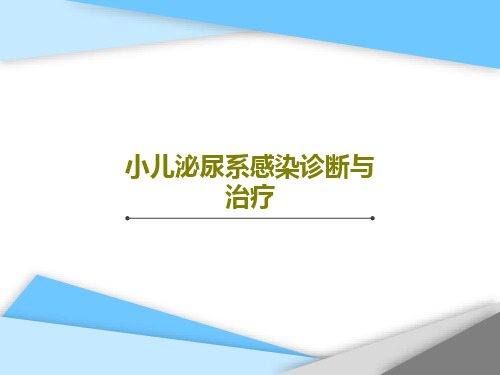
60、生活的道路一旦选定,就要勇敢地 走到底 ,决不 回头。 ——左
56、书不仅是生活,而且是现在、过 去和未 来文化 生活的 源泉。 ——库 法耶夫 57、生命不可能有两次,但许多人连一 次也不 善于度 过。— —吕凯 特 58、问渠哪得清如许,为有源头活水来 。—— 朱熹 59、我的儿
小儿泌尿系感染诊断与 治疗
6、纪律是自由的第一条件。——黑格 尔 7、纪律是集体的面貌,集体的声音, 集体的 动作, 集体的 表情, 集体的 信念。 ——马 卡连柯
8、我们现在必须完全保持党的纪律, 否则一 切都会 陷入污 泥中。 ——马 克思 9、学校没有纪律便如磨坊没有水。— —夸美 纽斯
10、一个人应该:活泼而守纪律,天 真而不 幼稚, 勇敢而 鲁莽, 倔强而 有原则 ,热情 而不冲 动,乐 观而不 盲目。 ——马 克思
- 1、下载文档前请自行甄别文档内容的完整性,平台不提供额外的编辑、内容补充、找答案等附加服务。
- 2、"仅部分预览"的文档,不可在线预览部分如存在完整性等问题,可反馈申请退款(可完整预览的文档不适用该条件!)。
- 3、如文档侵犯您的权益,请联系客服反馈,我们会尽快为您处理(人工客服工作时间:9:00-18:30)。
欧洲儿童泌尿系感染诊治指南解读(完整版)摘要泌尿系感染(UTI)是儿童常见的细菌感染性疾病,其中一些高危患儿可出现肾瘢痕,进而可致终末期肾脏病,恰当诊断和治疗UTI对于改善患儿预后十分重要。
关于儿童UTI的诊断和治疗尚存争议。
欧洲泌尿系学会/欧洲儿童泌尿系学会发布了新的儿童UTI诊治指南。
泌尿系感染(urinary tract infection,UTI)是儿童最常见的细菌感染性疾病之一,虽然多数患儿在急性期可以得到有效控制,但患儿初患UTI后6~12个月复发率高达30%,且在UTI患儿中存在相当比例的高危儿童,如30%的泌尿系畸形患儿以UTI为首发表现,85%伴发热的UTI患儿存在肾实质损害,其中10%~40%发生肾瘢痕,可致肾发育不良、反复肾盂肾炎、高血压和终末期肾脏病等。
UTI的有效诊断和治疗对于改善患儿预后至关重要,然而目前在UTI诊断和治疗方面尚存争议[1]。
2015年欧洲泌尿系学会(EAU)/欧洲儿童泌尿系学会(ESPU)儿童指南制定委员会根据最新证据发表了儿童UTI诊治指南[2],对高危患儿判断、预防性抗生素治疗和特殊影像学检查指征等争议问题进行了较为具体的论述,现对该指南进行解读。
1 UTI的分类与国内指南[3]略有不同,该指南根据感染部位、发病次数、症状和混杂因素对UTI进行了较为完整的分类(表1),其中对复发性UTI的定义仅按照发病次数,而不包含感染部位的因素。
表1泌尿系感染的分类及表现Table 1Classification and manifestation of urinary tract infection2 病史收集和体格检查要点该指南对病史收集和体检要点进行了阐述(表2),其中是否有便秘以往国内较少重视,有待关注。
表2泌尿系感染的病史收集和体格检查要点Table 2The key information on disease history and physical examination of urinary tract infection3 尿液和血液检查该指南强调尿液采集尽可能在抗生素应用前完成。
对于新生儿、小婴儿和未受过如厕训练的儿童,尿液采集方法有4种,其中塑料袋收集法尿液培养假阳性率高,当结果为阴性时较可靠,尿培养阳性不足以可靠诊断UTI。
若尿试纸检查白细胞酯酶和亚硝酸盐试验均为阴性或尿沉渣镜检既无脓尿又无菌尿可除外UTI。
清洁中段尿培养结果与经耻骨上膀胱穿刺取尿培养结果相关性较好,但污染率(26%)高于后者(1%)。
导尿法污染率较经耻骨上膀胱穿刺取尿法高,尤其对于6个月龄以下患儿、插导尿管困难和未行包皮环切的男童,因此指南建议,对于6个月以下儿童和未行包皮环切的男童,每次尝试导尿时使用1根新的无菌导管以减少污染。
经耻骨上膀胱穿刺是获得未被污染尿液的最敏感方法。
对于受过如厕训练的儿童,清洁中段尿检查准确性较好,强调检查前须清洁外阴。
若高度怀疑上尿路感染或病情严重者,推荐导尿或经耻骨上膀胱穿刺留取尿液。
尿液分析主要包括尿试纸检查和尿沉渣镜检。
尿试纸检查白细胞酯酶阳性和亚硝酸盐试验阳性对诊断UTI具有高度敏感性,两者均阴性可排除UTI。
尿沉渣显微镜检用于检测脓尿和菌尿,仅有菌尿与仅有脓尿比较诊断敏感性更高,如同时有菌尿和脓尿UTI诊断准确率高。
对于尿液常规分析结果正常者并存在其他发热原因或炎症体征者不必行尿培养,若常规检查异常必须行尿培养。
尿培养结果受尿液采集方法、利尿剂应用、尿液收集至检测之间的储存时间和储存温度影响。
根据该指南,如经耻骨上膀胱穿刺取尿培养菌落计数[每毫升集落生成单位(CFU/mL)]≥10 CFU/mL,导尿法取尿培养菌落计数≥1 000~50 000 CFU/mL,清洁中段尿培养菌落计数≥104 CFU/mL(有症状时)或≥105 CFU/mL(无症状时)可确诊UTI,与现行国内指南[3]判定标准中的清洁中段尿培养确诊标准为菌落计数>105 CFU/mL略有不同。
伴发热的UTI可导致脓毒症,也可出现一过性假性醛固酮减少症,表现为复杂的低钠血症伴或不伴高钾血症,多见于新生儿。
因此,对于伴发热的UTI患儿建议查血细胞计数和血电解质,重症患儿需查血培养。
C反应蛋白对于肾实质损害的预测特异性较低。
该指南指出,血清降钙素原增高可作为预测肾实质损害的可靠指标。
目前已有多篇文献证实血清降钙素原增高的预测价值[4,5],本指南所用证据主要来自Kotoula等[6]的研究结果,他们发现血清降钙素原>0.85 μg/L对上尿路感染有最佳预测价值,建议对血清降钙素原显著增高的患儿行99mTc二巯基丁二钠(DMSA)肾静态显像或排泄性膀胱尿路造影(voiding cystourethrogram,VCUG)检查。
4 泌尿系影像学检查4.1 超声检查该指南提出,超声检查适用于有疼痛或血尿的UTI患儿,对于所有伴发热的UTI患儿,如治疗24 h无改善均应行肾脏和膀胱超声检查。
若既往超声检查正常,可根据情况延迟检查时间。
该指南强调尽早超声检查的依据是治疗24 h无改善的患儿可能存在威胁生命的状况,有报道这些病例中15%~37%的患儿超声检查异常[7],有1%~2%的患儿需要进一步诊治,如进一步检查、转诊、分流或手术治疗。
在超声检查异常者中27%存在膀胱输尿管反流(vesicoureteral reflux,VUR)。
需重视的是,通常超声检查对扩张型VUR(dilating VUR)的漏诊率为24%~33%[2,8],在2岁以下伴发热的UTI患儿漏诊率可达64%。
指南中的扩张型VUR是指伴有肾盂和肾盏扩张的VUR。
Massanyi等[9]对144例2岁以下伴发热的UTI患儿进行回顾性研究发现,超声检查对Ⅳ~Ⅴ级VUR的漏诊率为64%。
因此,超声检查阴性不能除外VUR。
此外,该指南建议对于受过如厕训练的患儿,同时进行膀胱充盈和排空2个相位超声检查,以发现具有膀胱排空功能障碍的患儿;检查时还需注意直肠充盈情况,如果直肠充盈>30 mm,需考虑便秘[10],此点以往国内缺乏关注。
4.2 DMSA肾静态显像和VCUG检查以往指南未强调将DMSA肾静态显像和VCUG作为一线检查手段。
近年发现,超声检查对肾损害高危儿的漏诊率较高。
急性期UTI时DMSA 清除率的改变,表明存在肾盂肾炎或肾实质损害,这些改变与扩张型VUR 的存在、UTI复发风险及未来肾瘢痕形成风险有较好的相关性[11]。
绝大多数DMSA肾静态显像异常的患儿均存在扩张型VUR[12,13]。
具有VUR 的患者发生肾瘢痕者占37%,高于无VUR的UTI患者(12%)[14]。
根据以上证据,该指南指出,尽管排除VUR所需的检查,如VCUG或DMSA 肾静态显像具有有创性、可致患儿不适、检查时间较长或费用较贵等缺点,但不进行VCUG和/或DMSA肾静态显像不能诊断具有肾瘢痕形成高风险的VUR患者,强调了这2种检查的重要性,建议作为伴发热的UTI患儿排查VUR的一线检查手段,建议应用于伴发热的UTI患儿中的1岁以下患儿、1岁以上女童、1岁以上男童伴复发性发热性UTI者及受过如厕训练怀疑VUR的患儿。
为早期排除VUR以预防UTI复发,该指南建议DMSA 肾静态显像在UTI发病1~2个月进行。
需要注意,具有Ⅲ级以上VUR的新生儿在第1次症状性社区获得性UTI发病后DMSA肾静态显像结果可正常。
该指南也指出,VCUG仍是诊断VUR的金标准,应在UTI治愈后进行,在菌尿消失后早期行VCUG检查不会增加UTI发生率,行VCUG 检查时间不影响VUR的存在及严重性判断。
对于VCUG和DMSA肾静态显像检查顺序,可采用自下而上方案(先行VCUG检查后,若阳性再行DMSA肾静态显像),或自上而下方案(先行DMSA肾静态显像,若阳性再行VCUG)。
5 治疗该指南强调对于伴发热的具有UTI表现的患儿,应尽早开始抗生素治疗,以减少肾实质受累和肾瘢痕形成的风险。
主要治疗原则:(1)除非无症状菌尿引起临床问题或患儿计划手术治疗,否则不予抗生素治疗。
(2)3个月以上膀胱炎患儿,口服抗生素至少3~4 d。
(3)对于伴发热的UTI患儿,根据年龄、病情严重性、是否拒食拒水和拒服药物、是否伴呕吐或腹泻、依从性及是否存在混杂因素,如上尿路扩张等选择给药途径。
(4)新生儿和2个月以下婴儿尿脓毒症和严重肾盂肾炎发生率高,可发生危及生命的低钠血症和高钾血症等[15],推荐静脉给药。
(5)联合应用氨苄西林和氨基糖苷类(如妥布霉素或庆大霉素)或单用1种第3代头孢类抗生素治疗效果均很好。
应根据当地致病菌耐药情况和抗生素敏感谱及国家卫生部门政策选择抗生素。
(6)对于非大肠埃希菌感染导致的复杂型UTI患者,推荐静脉用广谱抗生素。
(7)对于伴发热的UTI,建议静脉抗生素治疗至患儿热退,之后口服抗生素7~14 d。
(8)若婴儿期患儿选择门诊治疗,需密切监测。
(9)对梗阻性肾病患者可能需要暂时的尿液引流。
通常,如治疗有效,尿液24 h后变为无菌,白细胞尿3~4 d消失。
90%的患者在治疗24~48 h体温恢复正常。
对于治疗无改善者需考虑抗生素耐药或存在先天性尿路畸形或急性泌尿系梗阻,应立即行超声检查。
6 预防用药关于预防用药一直存在争议。
根据瑞典一项研究,预防性抗生素治疗有助于预防具有Ⅲ级和Ⅳ级VUR的女婴发生新的肾瘢痕[16];根据Park 等[17]研究结果,对于1岁以内儿童,初次UTI发生早、高度VUR、双侧VUR及初次感染非大肠埃希菌者均有较高的复发风险。
为此,该指南建议,对于具有扩张型VUR的女童和UTI复发高危患儿及发生获得性肾损害高危患儿可考虑预防性抗生素治疗。
2014年N Engl J Med报道了一项关于VUR患儿随机干预研究,发现甲氧苄啶/磺胺甲唑预防性治疗2年将UTI复发风险降低了50%,特别是对于伴发热的UTI以及存在膀胱直肠功能障碍(bowel bladder syndrome,BBD)的患儿,但不影响肾瘢痕的形成风险[18,19]。
该指南建议以下药物可用于预防用药,包括呋喃妥因[1 mg/(kg·d),3个月龄以下不推荐]、甲氧苄啶[1 mg/(kg·d),6周龄以下不推荐]、甲氧苄啶磺胺甲唑[其中甲氧苄啶1~2 mg/(kg·d),磺胺甲唑10~15 mg/(kg·d)]、头孢克洛[10 mg/(kg·d),无年龄限制]和头孢克肟[2 mg/(kg·d),早产儿和新生儿不推荐]等。
上述药物中首选呋喃妥因、甲氧苄啶和甲氧苄啶磺胺甲唑,也可选用头孢菌素。
在具有产超广谱β-内酰胺酶(ESBL)细菌感染高发的地区,应慎重考虑应用头孢菌素。
